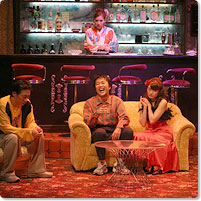Donju
(July, 2004 / Parco Theater)
Written by Kankuro Kudo
Directed by Masahiko Kawahara
Cast: Katsuhisa Namase, Narushi Ikeda, Arata Furuta, Naomi Nishida, Otoha, Maho Nonami
Data
:
First Performance: 2004
Performance time: approx. 2 hr. 30 min.
Acts / Scenes: 2 acts, 42 scenes
Cast: 6 (3 men, 3 women)
Kankuro Kudo
Donju (Dull Animal)

Kankuro Kudo
Kudo joined Suzuki Matsuo’s “Otona Keikaku” in 1991. Since he has demonstrated multiple talents as an actor, director, playwright, screenplay writer for movies and TV. He gained sudden acclaim for his script for the TV show “Ikebukuro West Gate Park. For his screenplay for the movie Kisarazu Cats’-eye he won the 2002 Minister of Culture and Science Award for Excellence in the Arts and the Japan Academy Award for Best Screenplay for the Movie Go . He his recognized for his skillful use of nonsense and black humor in fast-moving plots with lively dialogue. On the stage, he has performed as an actor with the Otona Keikaku company while also writing and directing a series of performances under the title Woman Lib. He has also formed the punk comic band “Group Tamashii” for which he is art director, songwriter (music and lyrics) and guitarist. In 2005 came the release of his first movie as director, Mayonaka no Yaji-san, Kita-san . For his play Donju he won the 49th Kishida Drama Award.

Shizuka tries to get clues to Dekogawa’s whereabouts by talking with his childhood friend Eda, who runs a host club called the Super Heavy, another former middle school classmate named Okamoto, Eda’s lover, Junko, who works as the Mama-san (matron) of another of Eda’s bars, and one of the bar’s hostesses, Nora.
The scenes are made up of a series of typical Kudo nonsense gags, big and small, that keep the laughter flowing as the plot unfolds through narrative recollections of the interviews with the four hometown acquaintances in format similar to listening to a 2-hour interview tape recording.
We are told that Dekogawa wandered into the bar a year ago, where he happened to meet Eda and Okamoto for the first time in 25 years. As the interviews proceed, a number of facts are revealed. For one thing, Dekogawa is not his real name. He came to be called Dekoyan because he looked a lot like a boy named Dekogawa who transferred into their elementary school. The real Dekogawa was killed one summer in middle school when he was hit by a train while running across the railroad bridge. And the body has never been found. But, in the sequel novel
Donju
(Dull Animal) being published in Shizuka’s magazine, things that only they could have known are appearing clearly in the story.
At this point the play is beginning to reflect doubts about which Dekogawa the present Dekogawa is and whether or not it is him that is actually writing the sequel novel.
As the sequel novel begins to gain popularity, Eda convinces Dekogawa to pay him the royalties from the book when it is published as compensation for being used as one of its models. In the meantime, fearing that more facts will be revealed to the public about the train bridge incident that sent the original Dekogawa to his death almost as certainly as murder, Eda plots to kill the current Dekogawa. However, no matter what they try, rat poison, nicotine extract, poison weed or clubbing him to death, Dekogawa keeps coming back to life.
The reason Dekogawa doesn’t die is that he is simply too insensitive. No matter how he is almost killed, he doesn’t even realize it, and he doesn’t even remember when he was a fellow student with these people. His insensitivity to the poisons and the injuries, and his dumb, misguided “concern” that makes him sign a contract to give up his book royalties to the people who are trying to kill him, all this “dullness” has made him ”stronger.”
Just at the point when they have decided to pack Dekogawa in a cardboard box and have a train run over him, the club’s telephone rings. It is from Shizuka, who has just arrived in town as and is asking directions to the club, which throws everything back to the beginning of the play. This begins a series of flashback scenes that work magnificently to bring to make the reflections catch up step by step to the present.
When we finally catch up completely to the present, we hear the screeching of a train’s brakes in the distance.
Hearing that Dekogawa isn’t dead, Shizuka is about to leave and return to the city. Just as she is heading for the door, Dekogawa appears, having lost an arm and a leg and also having a badly battered face. Who is this Dekogawa, though? Uncertainly, Shizuka asks him if he knows her. He replies, “I’m sorry, I don’t remember.”
Related Tags

